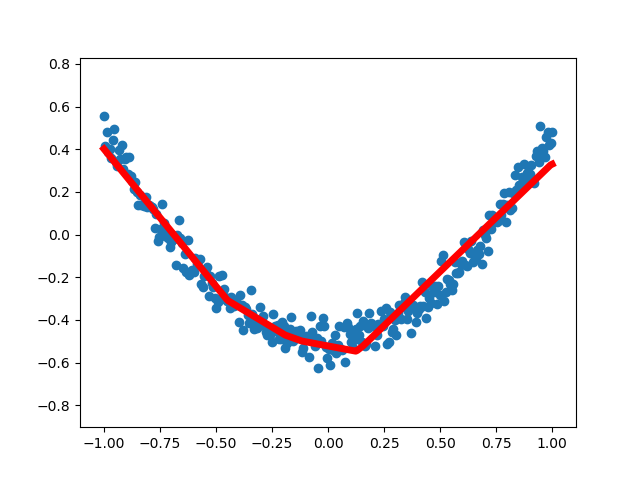# def 添加层 如何构造神经网络 并展示拟合过程 import tensorflow as tf import numpy as np import matplotlib.pyplot as plt # 若没有 pip install matplotlib # 定义一个神经层 def add_layer(inputs, in_size, out_size, activation_function=None): #add one more layer and return the output of the layer Weights = tf.Variable(tf.random_normal([in_size, out_size])) #in_size:上一层的节点数 out_size:当前的节点数 biases = tf.Variable(tf.zeros([1, out_size]) + 0.1) Wx_plus_b = tf.matmul(inputs, Weights) + biases if activation_function is None: outputs = Wx_plus_b else: outputs = activation_function(Wx_plus_b) return outputs # x_data值为-1到1之间,有300个单位(例子),即为1*300的行向量, # 通过[:, np.newaxis],再加一个维度newaxis,即300*1的列向量 x_data = np.linspace(-1, 1, 300)[:, np.newaxis] noise = np.random.normal(0, 0.05, x_data.shape) # 均值为0.方差为0.05,格式和x_data一样 y_data = np.square(x_data) - 0.5 + noise #1是指的数据的尺寸,None指的batch size的大小,所以可以是任何数,无论给多少个例子都行 xs = tf.placeholder(tf.float32, [None, 1]) ys = tf.placeholder(tf.float32, [None, 1]) # 设置输入层,隐藏层,输出层 # 输入层 l1 = add_layer(xs, 1, 10, activation_function=tf.nn.relu) # 输出层 prediction = add_layer(l1, 10, 1, activation_function=None) loss = tf.reduce_mean( # 对每个例子进行求和并取平均值 # reduction_indices参数,表示函数的处理维度, # reduction_indices=[1]指按行求和reduction_indices=[0]指按列求和 # 如果代码中并没有reduction_indices这个参数,该参数取默认值None,将把input_tensor降到0维,也就是一个数,即对所有数求和 tf.reduce_sum(tf.square(ys - prediction), reduction_indices=[1])) train_step = tf.train.GradientDescentOptimizer(0.1).minimize(loss) # 以0.1的学习效率对误差进行更正和提升 #两种初始化的方式 #init = tf.initialize_all_variables() init = tf.global_variables_initializer() sess = tf.Session() sess.run(init) fig = plt.figure() # 将figure设置的画布大小分成几个部分, # plt.subplot(2,2,1)参数‘221’表示2(row)x2(colu),即将画布分成2x2,两行两列的4块区域,1表示选择图形输出的区域在第一块, # 图形输出区域参数必须在“行x列”范围内, # 此处必须在1和2之间选择——如果参数设置为subplot(1,1,1),则表示画布整个输出,不分割成小块区域,图形直接输出在整块画布上 ax = fig.add_subplot(1, 1, 1) #设置画布的输入的数据为x_data y_data ax.scatter(x_data, y_data) #在使用matplotlib的过程中,常常会需要画很多图,但是好像并不能同时展示许多图。 这是因为python可视化库matplotlib的显示模式默认为阻塞(block)模式。 # 什么是阻塞模式那?我的理解就是在plt.show()之后,程序会暂停到那儿,并不会继续执行下去。如果需要继续执行程序,就要关闭图片。 # 那如何展示动态图或多个窗口呢?这就要使用plt.ion()这个函数,使matplotlib的显示模式转换为交互(interactive)模式。即使在脚本中遇到plt.show(),代码还是会继续执行。 plt.ion() plt.show() for i in range(1000): sess.run(train_step, feed_dict={xs: x_data, ys: y_data}) if i % 50 == 0: # to see the step improment 显示实际点的数据 print(sess.run(loss,feed_dict = {xs:x_data,ys:y_data})) try: # 每次划线前抹除上一条线,抹除lines的第一条线,由于lines只有一条线,则为lines[0],第一次没有线 ax.lines.remove(lines[0]) except Exception: pass # 显示预测数据 prediction_value = sess.run(prediction, feed_dict={xs: x_data}) # 存储 prediction_value 的值 lines = ax.plot(x_data, prediction_value, 'r-', lw=5) # 用红色的线画,且宽度为5 # 停止0.1秒后再画下一条线 plt.pause(0.1)
实验结果图展示:

附:参考https://www.cnblogs.com/likethanlove/p/6547405.html 通过图可以加深对tensorflow reduction_indices的理解:
